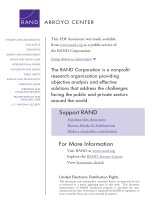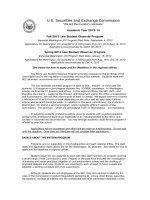THE DIRECTOR’S � BOOK pdf
Bạn đang xem bản rút gọn của tài liệu. Xem và tải ngay bản đầy đủ của tài liệu tại đây (1.78 MB, 124 trang )
THE ROLE
OF A NAT I O N A L
BANK DIRECTOR
THE
DIRECTOR’S
BOOK
Office of the Comptroller of the Currency
October 2010
Electronic copies of this book are available at the OCC’s Web site at
www.occ.treas.gov. To order printed copies, please e-mail requests to
Or send requests to
Office of the Comptroller of the Currency
ATTN: Publications
Mail Stop 2-3
Washington, DC 20219
PREFACE
A bank’s board of directors plays a critical role in the successful operation
of the bank. e health of a bank depends on a strong, independent,
and attentive board that adopts effective corporate governance
practices. e board has the fundamental responsibility of directing
the management of the bank’s business and affairs, and establishing a
corporate culture that prevents the circumvention of safe and sound
policies and procedures. In addition, directors have certain fiduciary
responsibilities to the bank’s shareholders, depositors, regulators, and
communities it serves.
e Office of the Comptroller of the Currency (OCC), the agency
responsible for regulating national banks,
1
recognizes the challenges
facing current and prospective bank directors. e OCC published this
book to help bank directors fulfill their duties in a prudent manner.
e book summarizes laws and regulations that directors should be
aware of and contains concepts and standards for the safe and sound
operation of a bank.
e Director’s Book was first published in 1987 and revised in 1997.
is 2010 edition updates the guidance to reflect legal and regulatory
changes since 1997. Directors should tailor their implementation of
the guidance in this book to reflect the size, scope of operations, and
risk profile of the bank on whose board they serve.
e guidance in this book does not constitute a legal opinion that
conduct consistent with it protects a director from liability. Conversely,
conduct inconsistent with such guidance does not necessarily result
in violation of the law and possible liability. Instead, directors should
1
e Dodd-Frank Wall Street Reform and Consumer Protection Act, signed into law on July 21,
2010, provides that supervisory authority for federal thrifts is to be transferred from the Office of
rift Supervision to the OCC. e date of the transfer must be within one year of enactment, with
the possibility of a six-month extension.
review their responsibilities and conduct on an ongoing basis and seek
advice from counsel when necessary.
e guidance in this book does not create rights for banks or bank
directors, or create obligations for the OCC. In particular, the OCC is
not bound by any internal procedures set forth in the guidance, other
than the extent to which the OCC may be bound by existing law.
Additional information on specific topics mentioned in this book can
be found on the OCC’s Web site at www.occ.treas.gov or on the OCC’s
National BankNet Web site at www.banknet.gov. National BankNet
is an OCC-operated Web site exclusive for national banks. BankNet
goes beyond standard Web-based services and enhances the private
exchange of information between the OCC and the banks it charters.
BankNet subscribers have access to numerous analytical tools that help
directors compare a bank’s performance with a custom peer group and
established benchmarks.
TABLE OF CONTENTS
Preface
CHAPTER I
e Board of Directors 1
Importance of the Board 1
Board Composition 3
e Board and the OCC 6
e Board’s Role in Risk Management 10
e Board and Other Regulators 17
CHAPTER II
e Board’s Responsibilities 19
Establish an Appropriate Corporate Culture 19
Hire and Retain Competent Management 21
Be Aware of the Bank’s Operating Environment 25
Maintain an Appropriate Board Structure 27
Monitor Operations 34
Oversee Business Performance 40
Serve Community Credit Needs 47
CHAPTER III
e Board’s Role in Planning and Policy 49
Planning 49
Policies 50
Major Policy Areas 52
CHAPTER IV
e Director’s Individual Responsibilities 70
Be Diligent 70
Be Loyal to the Bank’s Interests 74
CHAPTER V
Directors and the Law 77
Fiduciary Duties and Responsibilities 77
Statutory and Regulatory Liability 80
Indemnification and Insurance 92
CHAPTER VI
Administrative Actions 93
Actions Against National Banks 94
Actions Against Individuals 101
ACRONYMS 107
INDEX 108
I
THE BOARD OF DIRECTORS
IMPORTANCE OF THE BOARD
BOARD COMPOSITION
THE BOARD AND THE OCC
THE BOARD’S ROLE IN RISK MANAGEMENT
THE BOARD AND OTHER REGULATORS
IMPORTANCE OF THE BOARD
National banks, like other corporate organizations, have shareholders
who elect boards of directors. Bank directors face unique challenges,
however, because banks differ from other corporations. Although
banks, like other corporations, use their capital to support their
activities, most of the funds banks put at risk belong to others, primarily
depositors. Banks lend and invest customers’ deposits to earn profits
and reasonable returns to shareholders and to meet the credit needs of
their communities. Generating a return to shareholders with depositors’
funds requires that the board prudently consider the risks that a bank
undertakes. Properly managing these risks is a critical challenge faced
by the board and bank management.
Directors of a national bank are accountable not only to their share-
holders and depositors but also to their regulators. Banks are regulated
in part because Congress provides for federal insurance of deposits while
also subjecting banks to regulatory oversight. is regulatory oversight
is appropriate because of the risks inherent in the banking system, the
safety net provided by deposit insurance, and the importance of a safe
and sound banking system to the nation’s economy.
e board sets the tone and direction of the bank and establishes
guidelines on the nature and amount of risk the bank may take. e
THE D IRECTOR’S BO OK • THE ROLE OF A NATIONAL BANK DIRECTOR 1
board oversees and supports management’s efforts, reviews manage-
ment’s recommendations before approving or rejecting them, and makes
sure that adequate controls and systems exist to identify and manage
risks and address problems. e bank’s systems and controls, as well as
the volume and complexity of the controls, should be appropriate to the
bank’s size, the nature and scope of its operations, and its risk profile.
e issues that the board faces are generally dictated by the nature and
scope of the bank’s operations. e size of the bank, however, does
not necessarily mean that the bank does not offer sophisticated bank
products. e board of a smaller bank may need to be as familiar with
more sophisticated bank products as the board of a larger bank.
In difficult economic times or when management is ineffective, an
active, involved board can help a bank survive. During these times, the
board must evaluate the bank’s problems, take appropriate corrective
actions, and, when necessary, keep the bank operating until the board
ensures that management is again effective and the bank’s problems
have been resolved.
A board should perform a self-assessment of its effectiveness periodically
and determine whether it is taking the steps necessary to correct
deficiencies. It also should review how well board committees are
meeting their responsibilities. Bank counsel, auditors, or other advisors
can often assist the board in these efforts. OCC examiners evaluate how
well the board meets its responsibilities and make recommendations for
improvement if they find weaknesses.
A board should conduct orientation programs for new directors. While
these programs vary based on the bank’s size and complexity, at a
minimum these programs should explain the operation of the bank and
the banking industry and clearly outline the responsibilities of board
members, individually and as a group. Ongoing education programs
that describe local and overall economic conditions, emerging industry
developments, opportunities, and risks also are important tools for
maintaining director expertise and board effectiveness.
THE D IRECTOR’S BO OK • THE ROLE OF A NATIONAL BANK DIRECTOR 2
BOARD COMPOSITION
A board’s effectiveness depends in large part on how well its members
work together to identify and address issues important to the bank’s
future. A national bank must have at least five, but no more than 25,
directors. e board and shareholders establish the number of directors
in the bank’s bylaws.
Membership on a bank’s board gives a person a valuable opportunity
to share his or her expertise with the bank, help the community,
and advance professionally. e position of director is prestigious,
identifying the incumbents as trusted and respected members of the
communities in which the bank operates. At the same time, a well-
respected individual’s alliance with a bank may lend stature to the bank.
Board membership is also an opportunity to contribute to the local
economy’s growth and development.
Typically, a board includes individuals who are bank officers or
employees—called “management” or “inside” directors—and “outside”
directors who are neither officers nor employees of the bank. Outside,
independent
2
directors bring experiences from their fields of expertise.
ese experiences provide perspective and objectivity as the director
oversees bank operations and evaluates management recommendations.
When searching for new directors, boards should seek individuals who
exercise independent judgment and who actively participate in decision
making. e principal qualities of an effective bank director include
strength of character, an inquiring and independent mind, practical
wisdom, and sound judgment. Some boards establish additional
criteria to supplement these attributes. ese may include individual
qualifications, such as technical skills, career specialization, or specific
backgrounds. Such criteria may change over time if, for example,
2
Generally, a director is viewed as independent if he or she is a non-management director free of any
family relationship or any material business or professional relationship (other than stock ownership
and the directorship itself) with the bank or its management. Additional requirements for meeting the
independence standard are required by the Sarbanes-Oxley Act for public banking companies and by
12 CFR 363 for larger banking companies.
THE D IRECTOR’S BO OK • THE ROLE OF A NATIONAL BANK DIRECTOR 3
the bank plans to offer new products or services or expand beyond
current markets.
e board’s nominating procedures can help identify and retain
qualified directors. Many banks nominate directors on the basis of their
independence, diversity, technical qualifications, and capabilities. Many
directors are also selected because of their position in the community or
their relationship to the bank (for example, a large shareholder).
Prospective directors should determine whether the bank’s board
actively oversees bank operations. If directors, outside directors in
particular, are not encouraged to actively contribute and participate
in board discussions, prospective directors should weigh this carefully
against their impending responsibilities and corresponding potential
liabilities when deciding whether to serve.
In most cases, individuals nominated as national bank directors serve
in that capacity immediately after they are approved in accordance with
the bylaws. If, however, the bank is not in compliance with minimum
capital requirements, is in a troubled condition, or is not in compliance
with a directive to correct a problem promptly, the bank must file a
notice with the OCC about proposed new directors before they can
serve on the board. e OCC also may object to proposed directors of
new banks during the first two years the bank is in business.
When prior notice is required, the OCC conducts background checks
and reviews the biographical and financial information submitted
by the proposed director. e OCC has 90 days to disapprove the
nomination of a proposed director.
In addition to the citizenship and residency requirements contained
in 12 USC 72, the qualifications of a candidate seeking to become a
member of the board of directors of a national bank include
□ Basic knowledge of the banking industry, the financial regulatory
system, and the laws and regulations that govern the operation of
the institution.
THE D IRECTOR’S BO OK • THE ROLE OF A NATIONAL BANK DIRECTOR 4
□ Willingness to put the interests of the bank ahead of personal
interests.
□ Willingness to avoid conflicts of interests.
□ Knowledge of the communities served by the bank.
□ Background, knowledge, and experience in business or another
discipline to facilitate oversight of the bank.
□ Willingness and ability to commit the time necessary to prepare for
and regularly attend board and committee meetings.
ADVISORY DIRECTORS
Some institutions supplement their boards with advisory directors,
with titles such as associate directors, honorary directors, or directors
emeriti. Advisory directors may serve the board, directly or indirectly,
through an advisory board. ese individuals provide information and
advice but do not vote as part of the board.
A board with advisory directors generally brings a broader perspective
to a bank. Advisory directors are often former directors of newly
purchased banks and may represent a large constituency of customers
or communities that are not otherwise represented on the board. A
bank may use advisory directors in the following situations:
□ When the operations of the bank are geographically dispersed and
the board wants input from more segments of the communities
served by the bank.
□ When the board itself is small and the directors want direct
involvement with a broader array of community leaders.
□ To assist in business development.
□ To gain access to special expertise to assist the board in its planning
and decision-making activities.
□ To help identify likely candidates for future board openings.
Because of their limited role, advisory directors generally are not
liable for board decisions. e facts and circumstances of a particular
situation, however, as well as whether an advisory director functions
THE D IRECTOR’S BO OK • THE ROLE OF A NATIONAL BANK DIRECTOR 5
in effect as a full director, are likely to determine whether an advisory
director may have liability for individual decisions, including factors
such as
□ Whether advisory directors were elected or appointed.
□ How advisory directors are identified in corporate documents.
□ How advisory directors participated in board meetings.
□ Whether advisory directors exercised significant influence on the
voting process.
□ How advisory directors were compensated for attending board
meetings.
□ Whether the advisory director had a prior relationship with the
bank.
An advisory director who in fact functions as a full director may be
liable for board decisions in which he or she participated as if that
person were a full director. Individuals cannot shield their actions from
liability simply by inserting the word “advisory” in their title.
THE BOARD AND THE OCC
SUPERVISORY ACTIVITIES
e OCC supervises national banks by conducting on-site
examinations and by performing periodic monitoring. ese activities
help determine the condition of individual banks and the overall
stability of the national banking system. e OCC and other federal
bank regulatory agencies use the Uniform Financial Institutions Rating
System, or “CAMELS,” to assign composite and component ratings to
banks.
3
e frequency of OCC on-site examinations is determined by
the bank’s size, complexity, risk profile, and condition. ese on-site
examinations are conducted either annually or up to every 18 months
(unless the bank is experiencing problems, in which case it may be
examined more frequently).
3
A bank’s composite CAMELS rating integrates ratings from six component areas—capital adequacy,
asset quality, management, earnings, liquidity, and sensitivity to market risk. e ratings range from 1
to 5 with 1 being the highest rating and least supervisory concern.
THE D IRECTOR’S BO OK • THE ROLE OF A NATIONAL BANK DIRECTOR 6
Examiners meet with bank management during the examination
to obtain information or to discuss issues. When the examination is
complete, the examiners prepare a report of examination and conduct
a meeting with the bank’s board of directors (except for some smaller
affiliates of large banks, in which case the meeting may be conducted
with the lead bank’s board) to discuss the results of the examination.
Each director is responsible for thoroughly reviewing and signing the
report of examination.
An environment in which examiners and board members openly and
honestly communicate benefits a bank. OCC examiners have experience
with a broad range of banking activities and can provide independent,
objective advice on safe and sound banking principles and compliance
with laws and regulations.
Directors are encouraged to meet with OCC examiners to discuss
the condition of the bank and the results of the examination.
Outside directors may choose to meet with OCC examiners without
management’s presence. Directors should pay close attention to and
review carefully any written communications from the OCC. ey
should ask questions and raise issues of concern. Directors also should
ensure that bank management completes any specific follow-up actions
in a timely manner.
e activities of OCC examiners do not diminish the board’s
responsibilities to oversee the management and operation of the bank.
Directors are independently responsible for knowing the condition of
the bank and should not rely on the examiners as their sole source of
information to identify or correct problems. Instead, the board should
look to its senior management, its auditors, and other outside experts
to identify and correct any problems.
THE D IRECTOR’S BO OK • THE ROLE OF A NATIONAL BANK DIRECTOR 7
APPEALS PROCESS
e OCC desires consistent and equitable supervision and seeks to
resolve disputes that arise during the supervisory process fairly and
expeditiously in an informal, professional manner. When disputes
cannot be resolved informally, the board of directors of a national bank
may ask its supervisory office to review the disputed matter or appeal
the matter to the OCC Ombudsman.
Functioning as an independent adviser and decision maker, the OCC
ombudsman can accept appeals from boards of directors related to,
for example, examination ratings, the adequacy of loan loss reserve
positions, and significant loan classifications. e ombudsman may not
accept appeals related to the appointment of receivers and conservators,
preliminary examination conclusions communicated to a national
bank before a final report of examination is issued, enforcement-related
actions or decisions, formal and informal rulemakings pursuant to
the Administrative Procedures Act, or requests for information filed
under the Freedom of Information Act. With the prior consent of the
Comptroller of the Currency, the ombudsman may stay an appealable
agency decision or action during the resolution of an appealable matter.
COMPLIANCE WITH LAWS AND REGULATIONS
A board of directors should be aware that, in addition to the OCC’s
supervisory responsibilities, the agency enforces banking and other laws
and regulations that apply to national banks. For example, the OCC
enforces compliance with the legal lending limit, which restricts the
amount a bank may lend to a single borrower (or to related borrowers
that are financially interdependent) to prevent undue concentrations
of credit. Other banking laws the OCC enforces include restrictions
on loans to insiders and transactions with affiliates. Insider and affiliate
transaction laws are intended to prevent the misuse of a bank’s resources
by such persons or companies.
THE D IRECTOR’S BO OK • THE ROLE OF A NATIONAL BANK DIRECTOR 8
Other laws and regulations under OCC purview include those designed
to protect consumers
4
or to facilitate broader law enforcement efforts.
For example, the OCC administers compliance with the Equal Credit
Opportunity Act, a law that requires lenders to make credit decisions
without discriminating on the basis of certain enumerated factors. e
OCC’s law enforcement efforts include examining for, and enforcing
compliance with, the Bank Secrecy Act (BSA), Anti-Money Laundering
program requirements, and Office of Foreign Assets Control regulations.
e OCC also assesses a bank’s performance under the Community
Reinvestment Act (CRA).
REGULATION OF PROBLEM BANKS
Problem banks generally have composite CAMELS ratings of 3, 4, or 5
and often possess one or more of the following deficiencies:
□ Excessive growth or aggressive growth strategies.
□ Ineffective or dishonest management.
□ Insider abuse and fraud.
□ Excessive amount of low-quality assets or inordinate concentrations
of credit.
□ Insufficient capital.
□ Inadequate policies, procedures, or internal controls.
□ Deferred loan loss provisions, chargeoffs, or recognition of securities
impairment.
□ Strained liquidity, including reliance on brokered deposits.
□ Significant medium- and long-term interest rate risk exposure.
□ Lack of a viable strategic plan.
□ Failure of the board or senior management to understand the bank’s
activities and their risks.
4
Under the Dodd-Frank Wall Street Reform and Consumer Protection Act, effective July 21, 2011,
the Bureau of Consumer Financial Protection will assume certain designated consumer financial
protection functions of the OCC for banks with more than $10 billion in assets.
THE D IRECTOR’S BO OK • THE ROLE OF A NATIONAL BANK DIRECTOR 9
When the OCC identifies or communicates problems or weaknesses
to a bank, the bank’s senior management and board of directors are
expected to promptly correct them. e actions the bank takes or
agrees to take in response to problems or weaknesses are important
factors in determining whether the OCC takes enforcement action and
the severity of that action. If the OCC believes a bank has significant
weaknesses, the OCC may conclude that the bank requires additional
or special supervision. In such cases, the OCC usually examines and
monitors the bank more frequently. e OCC works with the board
and bank management to determine necessary corrective action to
return the bank to a safe and sound condition.
A problem bank becomes subject to a number of enhanced regulatory
restrictions as its composite or component CAMELS ratings or Prompt
Corrective Action capital category declines or when it is subject to a
formal enforcement action. e board is responsible for ensuring that
bank management is aware of such restrictions and complies with them.
THE BOARD’S ROLE IN RISK MANAGEMENT
e OCC recognizes that banking is a business of assuming risks
in order to earn profits. Risk levels, however, must be appropriately
managed. A bank’s safety and soundness are contingent upon effectively
managing its risk exposures. Some transactions or activities may expose
a particular bank to a level of risk so great that its board may reasonably
conclude that no amount of sound risk management can effectively
control it.
To manage risk effectively, a bank must have a well-informed board of
directors that guides its strategic direction. A key component of strategic
direction is establishing the bank’s risk tolerance. e board establishes
the bank’s risk tolerance by approving policies that set standards for the
nature and level of risk the bank is willing to assume. ese policies
should generally be written and periodically reviewed and updated.
After adopting policies, the board must ensure that its guidance
is effectively communicated and adhered to throughout the bank.
A well-designed monitoring system is the best way for the board to
THE D IRECTOR’S BO OK • THE ROLE OF A NATIONAL BANK DIRECTOR 10
hold management accountable for operating within established risk
tolerance levels.
Capable management and appropriate staffing are essential to
effective risk management. Bank management is responsible for the
implementation, integrity, and maintenance of risk management
systems. Management must
□ Keep the directors adequately informed about the bank’s activities.
□ Implement the board-approved strategic direction.
□ Develop policies that reflect the bank’s risk tolerance and that are
compatible with the bank’s strategic direction.
□ Oversee the development and maintenance of management
information systems that provide timely, accurate, and pertinent
information.
□ Ensure that the strategic direction and risk tolerances are effectively
communicated and adhered to throughout the organization.
Because market conditions and bank structures vary, no single risk
management system works for all banks. Each bank should develop its
own risk management system tailored to its needs and circumstances.
e sophistication of the risk management system increases with the
size, complexity, and geographic diversity of each bank. All sound risk
management systems, however, have several common fundamentals.
For example, bank staff responsible for implementing sound risk
management systems should perform those duties independently of the
bank’s risk-taking activities. Regardless of the risk management system’s
design, it should include mechanisms for identifying, measuring,
monitoring, and controlling risks:
□ Identifying. Proper risk identification focuses on recognizing and
understanding existing risks or risks that may arise from changing
economic conditions or new business initiatives. Risk identification
should be a continuous process, and risks should be understood at
both the transaction (individual) and portfolio (aggregate) level. As
part of its identification process, banks should consider not only
the risks arising from normal or “business as usual” conditions, but
THE D IRECTOR’S BO OK • THE ROLE OF A NATIONAL BANK DIRECTOR 11
also the nature and level of risks that may arise from more adverse
or “stressed” conditions.
□ Measuring. Accurate and timely measurement of risk is essential to
effective risk management systems. A bank that does not have risk
measurement tools has limited ability to control or monitor risk
levels. e sophistication of the risk measurement tools a bank uses
should reflect the type and complexity of its products and services.
All banks should periodically test their measurement tools to make
sure they are accurate. Sound risk measurement tools assess the
risks at the transaction and portfolio levels.
□ Monitoring. e bank should monitor risk levels to ensure timely
review of risk positions and exceptions. Monitoring reports should
be timely, accurate, and informative, and should be distributed to
appropriate individuals for action, when needed.
□ Controlling. e bank should establish and communicate risk
limits through policies, standards, and procedures that define
responsibility and authority. ese limits should serve as a means
to control exposures to the various risks associated with the bank’s
activities. e limits should be tools that management can adjust
when conditions or risk tolerances change. e bank should have
a process to authorize and document exceptions or changes to risk
limits when they are warranted.
OCC’S SUPERVISION BY RISK PROGRAM
is overview of the OCC’s supervision by risk program is included to
provide boards of directors with a general description of the importance
of risk management to banking. More detail on the supervision by risk
program can be found in the “Bank Supervision Process” booklet of the
Comptroller’s Handbook.
e OCC’s supervision of national banks is directed at identifying
significant or emerging problems in individual banks and the banking
system and ensuring that such problems are appropriately corrected.
Because banking is essentially a business of assuming and managing
risk, the OCC has adopted a supervisory philosophy that is centered
on evaluating risks and risk management systems. e OCC applies
THE D IRECTOR’S BO OK • THE ROLE OF A NATIONAL BANK DIRECTOR 12
this philosophy to all supervisory activities it conducts, including safety
and soundness, information technology, compliance, and fiduciary
activities.
Supervision by risk consists of determining the quantity of risk exposure
in a bank and evaluating the quality of risk management systems in
place to control risk. Supervision by risk provides consistent definitions
of risk, a structure for assessing these risks, and integration of risk
assessment in the supervisory process.
Supervision by risk places the responsibility for controlling risks with
the board of directors and management. e OCC assesses how well
a bank manages its risks over time, rather than assessing only the
condition at a single point in time.
CATEGORIES OF RISK
Risk is the potential that events, expected or unanticipated, may have
an adverse effect on a bank’s earnings, capital, or enterprise value. To
achieve more comprehensive and efficient examinations of national
banks, the OCC has defined eight categories of risk inherent in bank
activities. ese risks may be both current and prospective and are not
mutually exclusive, because any product or service may expose a bank
to multiple risks. e risks may also be interdependent—an increase in
one category may cause an increase in others. For analysis and discussion
purposes, however, the OCC identifies and assesses the risks separately.
e following is a brief description of the eight risks. A more
complete discussion of these risks is contained in the “Community
Bank Supervision” and “Large Bank Supervision” booklets of the
Comptroller’s Handbook. e OCC does not require banks to adopt
its risk definitions. Directors and bank management should, however,
understand the nature of these risks and ensure that the bank’s risk
management systems adequately address all relevant risks.
□ Credit risk. e risk to earnings or capital arising from an obligor’s
failure to meet the terms of any contract with the bank or otherwise
to perform as agreed. Credit risk is found in all activities where
THE D IRECTOR’S BO OK • THE ROLE OF A NATIONAL BANK DIRECTOR 13
success depends on counterparty, issuer, or borrower performance.
It arises any time bank funds are extended, committed, invested,
or otherwise exposed through actual or implied contractual
agreements, whether reflected on or off the balance sheet.
□ Interest rate risk. e risk to earnings or capital arising from
movements in interest rates. Interest rate risk arises from differences
between the timing of rate changes and the timing of cash flows
(repricing risk), from changing rate relationships among different
yield curves affecting bank activities (basis risk), from changing rate
relationships across the spectrum of maturities (yield curve risk),
and from interest-related options embedded in bank products
(options risk).
□ Liquidity risk. e risk to earnings or capital arising from a bank’s
inability to meet its obligations when they come due without
incurring unacceptable losses. Liquidity risk includes the inability
to manage unplanned decreases or changes in funding sources.
Liquidity risk also arises from the failure to recognize or address
changes in market conditions that affect the ability to liquidate
assets quickly and with minimal loss in value.
□ Price risk. e risk to earnings or capital arising from changes in
the value of either trading portfolios or other obligations that are
entered into as part of distributing risk. ese portfolios are typically
subject to daily price movements and are accounted for primarily
on a mark-to-market basis. is risk arises most significantly
from market-making, dealing, and position-taking in interest
rate, foreign exchange, equity, commodities, and credit markets.
Price risk also arises in banking activities whose value changes are
reflected in the income statement, such as in lending pipelines and
mortgage servicing rights. e risk to earnings or capital arising
from the conversion of a bank’s financial statements from foreign
currency translation is also price risk.
□ Operational risk. e risk to earnings or capital arising from
inadequate or failed internal processes or systems, the misconduct
or errors of people, and adverse external events. Operational losses
result from internal fraud; external fraud; employment practices
and workplace safety; clients, products, and business practices;
THE D IRECTOR’S BO OK • THE ROLE OF A NATIONAL BANK DIRECTOR 14
damage to physical assets; business disruption and systems failures;
and execution, delivery, and process management.
□ Compliance risk. e risk to earnings or capital arising from
violations of, or nonconformance with, laws, rules, regulations,
prescribed practices, internal policies and procedures, or ethical
standards. Compliance risk also arises in situations where the laws
or rules governing certain bank products or activities of the bank’s
clients may be ambiguous or untested. is risk exposes the bank to
fines, civil money penalties, payment of damages, and the voiding
of contracts. Compliance risk can lead to diminished reputation,
reduced enterprise value, limited business opportunities, reduced
expansion potential, and an inability to enforce contracts.
□ Strategic risk. e risk to earnings, capital, or enterprise value
arising from adverse business decisions, improper implementation
of decisions, or lack of responsiveness to industry changes. is risk
is a function of the compatibility of an organization’s strategic goals,
the business strategies developed to achieve those goals, the resources
deployed, and the quality of implementation. e resources needed
to carry out business strategies are both tangible and intangible.
ey include communication channels, operating systems,
delivery networks, and managerial capacities and capabilities. e
organization’s internal characteristics must be evaluated against
the effect of economic, technological, competitive, regulatory, and
other environmental changes.
□ Reputation risk. e risk to earnings, capital, or enterprise value
arising from negative public opinion. is risk affects the bank’s
ability to establish new relationships or services or continue
servicing existing relationships. is risk may expose the bank to
litigation or financial loss, or impair its competitiveness or ability
to attract or retain funding or capital. Reputation risk exposure is
present throughout the bank and requires management to exercise
an abundance of caution in dealing with customers, investors, and
the community.
THE D IRECTOR’S BO OK • THE ROLE OF A NATIONAL BANK DIRECTOR 15
EVALUATING A BANK’S RISK MANAGEMENT SYSTEM
e board should ensure that bank management adequately identifies
the risks associated with particular activities and has put in place systems
and controls to manage those risks. When OCC examiners assess a
bank’s risk management system, they consider policies, processes,
personnel, and control systems. A significant deficiency in one or more
of these components constitutes a deficiency in risk management. All
of these components are important, but the sophistication of each may
vary depending on the bank’s complexity. Noncomplex community
banks normally have less formalized policies, processes, and control
systems in place than do large or more complex banks.
□ Policies are written or verbal statements of the bank’s commitment
to pursue certain results. ey set standards and courses of action
to achieve specific objectives established by the board. Policies
should be consistent with the bank’s underlying mission, values,
and principles. ey also clarify the bank’s tolerance for risk.
Mechanisms should be in place to trigger a review of policies in the
event that activities or objectives change.
□ Processes are the procedures, programs, and practices that impose
order on the bank’s pursuit of its objectives. Processes define how
daily activities are carried out. Effective processes are consistent with
the underlying policies and are governed by appropriate checks and
balances.
□ Personnel are the bank staff and managers who execute or oversee
processes. Personnel should be qualified and competent and should
perform as expected. ey should understand the bank’s mission,
values, policies, and processes. Compensation programs should be
designed to attract, develop, and retain qualified personnel and
encourage strong risk management practices that appropriately
balance risk and reward.
THE D IRECTOR’S BO OK • THE ROLE OF A NATIONAL BANK DIRECTOR 16
□ Control systems are the tools and information systems that bank
managers use to measure performance, make decisions about
risk, and assess the effectiveness of processes. e audit program
is a critical element of the bank’s control systems. Feedback from
these tools and information systems must be timely, accurate, and
pertinent.
When risks are excessive or not properly managed, the OCC works
with the board and bank management to determine necessary corrective
action.
THE BOARD AND OTHER REGULATORS
e boards of directors of national banks may have occasion to contact
federal bank regulatory agencies other than the OCC, namely, the Board
of Governors of the Federal Reserve System and the Federal Deposit
Insurance Corporation (FDIC). e following table summarizes the
primary and secondary supervisory responsibilities of the three bank
regulatory agencies. e table also shows that these agencies have
jurisdictions that sometimes overlap. When this occurs, the agencies
work together and share information to reduce burden to both the
bank and the agencies.
Bank Regulatory Agency Supervisory Responsibility
a
OCC National Banks (Primary)
Federal Branches and Agencies of Foreign Banks (Primary)
Board of Governors of the
Federal Reserve System
Bank Holding Companies (Primary)
State Member Banks (Primary)
National Banks (Secondary)
Federal Branches and Agencies of Foreign Banks (Secondary)
FDIC Insured State Nonmember Banks (Primary)
Insured National Banks (Secondary)
Insured State Member Banks (Secondary)
Insured Branches and Agencies of Foreign Banks (Secondary)
a
e Dodd-Frank Wall Street Reform and Consumer Protection Act, signed into law on July 21,
2010, provides that supervisory authority for federal thrifts, state thrifts, and thrift holding companies
is to be transferred from the Office of rift Supervision to the OCC, FDIC, and Federal Reserve,
respectively. e date of the transfer must be within one year of enactment, with the possibility of a
six-month extension.
THE D IRECTOR’S BO OK • THE ROLE OF A NATIONAL BANK DIRECTOR 17









